Today we are looking at the Intel Xeon Processor E5-1650 which is perhaps the sweet spot for LGA 2011 Xeon processors. With 6 cores, 12 threads running at 3.2GHz base and 3.8GHz max 12MB of cache, the Intel Xeon Processor E5-1650 is a more than capable CPU for multi-threaded workloads. For those wondering, the LGA 2011 Xeon E5 series CPUs have 40 PCIe 3.0 lanes each. That is how dual socket systems get 80 lanes. Compare this to the desktop Core i7-3930K and one will note that the Xeon E5-1650 supports ECC DDR3 and up to 375GB of ram compared to the Core i7-3930K’s 64GB maximum memory support. With quad channel memory support the Xeon E5-1650 supports up to 51.2GB/s of memory bandwidth with 1600MHz DDR3 compared to the Ivy Bridge based Intel Xeon processor E3-1290 V2 with its 25.6GB/s of memory bandwidth. Overall, I view the Intel Xeon E3 series as being fast CPUs with modest infrastructure and the Intel Xeon E5 series as being big CPUs with big infrastructure around them.
Intel Xeon Processor E5-1650 Test Configuration
One thing I wanted to do with all LGA 2011 reviews was to test stability using the maximum number of DIMMs. Frankly, one of the most compelling features of the LGA 2011 and its Intel Xeon and Intel Core i7 CPUs, single socket desktop platform is the ability to utilize up to eight DIMMs, which is something a user would have previously needed a dual socket system or a single socket AMD G34 platform to do.
- CPU(s): Intel Xeon E5-1650
- Motherboard: ASUS P9X79 WS
- Memory: 32GB (8x 4GB) G.Skill Ripjaws X DDR3 1600
- Drives: Corsair Force3 120GB, OCZ Vertex 3 120GB
- Chassis: Norco RPC-4220
- Power Supply: Corsair AX850 850w 80 Plus Gold
Intel Xeon Processor E5-1650 Performance Tests
I will start off this section by saying that the standard test suite was built to test 1-8 thread single CPU systems such as the Sandy Bridge and Ivy Bridge Intel Xeon CPUs. With platforms like this one, I have been slowly altering the mix. Clearly, one would expect a different workload between dual Xeon E5-2690 CPUs and something found in a low-end, low-power server like a Pentium G630. Moving to the 16-64 core realm where the Xeon E5 series will play, that is becoming the norm today, I think that it will become ever more important to develop a second test suite.
Intel Xeon Processor E5-1650 Cinebench R11.5
I have been using Cinebench benchmarks for years but have held off using them on ServeTheHome.com because the primary focus of the site until the past few months has been predominantly storage servers. With the expansion of the site’s scope, Cinebench has been added to the test suite because it does represent a valuable benchmark of multi-threaded performance. I have had quite a few readers contact me about this type of performance for things like servers that are Adobe CS6 compute nodes and similar applications. Cinebench R11.5 is something that anyone can run on their Windows machines to get a relative idea of performance and both Ivy Bridge, Sandy Bridge and Sandy Bridge-EP systems run it well.
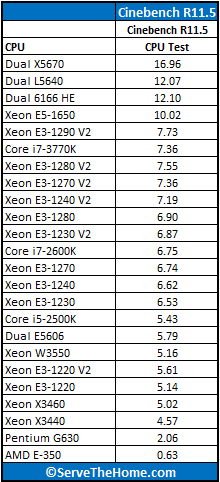
Here we see another nice improvement over the Ivy Bridge based Intel Xeon CPUs such as the Intel Xeon E3-1290 V2 which is actually about 50% more expensive than the Intel Xeon E5-1650. Also, I do like to keep some interesting comparisons in here. Note the Intel Xeon processor E5-1650 is nearing dual dodeca (12) core AMD Opteron parts represented by the Opteron 6166HE chips.
Intel Xeon Processor E5-1650 7-Zip Compression Benchmark
7-Zip is an immensely popular compression application with an easy to use benchmark.
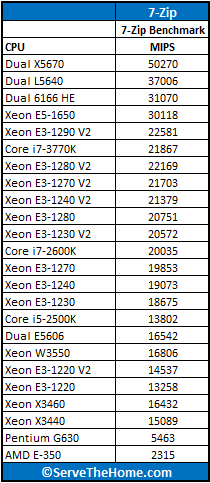
Again, the Intel Xeon processor E5-1650 is trending above the much more expensive Intel Xeon processor E3-1290 V2 and is very similar, in terms of performance, to the dual Opteron 6166HE setup.
Intel Xeon Processor E5-1650 TrueCrypt Encryption Benchmarks
With Intel’s focus on its AES-NI features TrueCrypt can look a bit skewed. Unlike some dubious drivers over the years that were optimized for benchmarks over real world application, Intel’s AES-NI feature does encompass the addition of specialized hardware. This specialized hardware has many practical uses and is becoming more supported. For example, users of Solaris 11 can utilize the AES-NI features to see much higher throughput on encrypted volumes. AMD has started offering AES-NI with their Bulldozer CPUs, and I will have those results added to future pieces. Let’s see how Intel does here.
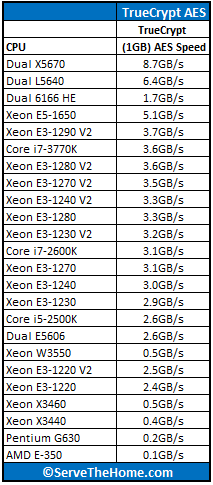
Here we see the Xeon E5-1650 absolutely crush the AMD Opteron system (due to Magny Cours not being able to use AES accelleration) and the entire Ivy Bride Xeon line including the Intel Xeon E3-1290 V2.
Intel Xeon Processor E5-1650 Handbrake 0.9.5 x264 Encoding Benchmarks
I am still using Handbrake v0.9.5 simply because the Handbrake team does do some nice tweaking between annual versions and all of the other CPUs have been tested with v0.9.5. We will begin to collect data on v0.9.6 and start using that once we have critical mass. Either way, Handbrake is an extremely popular x264 encoding and transcoding application as it is very common practice these days to encode video for various tablets, phones and other devices. These transcodes also take a fair amount of time so having faster CPUs is important.
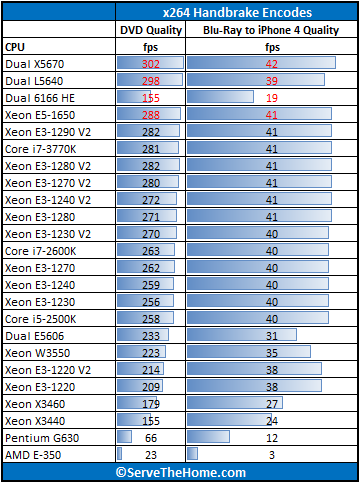
One big note here is that Handbrake is getting updated for GPU compute, and Intel has Quick Sync on its Intel Core i7 generation processors, such as the Core i7-3770K. For media encoding, if ECC is not an issue, the Core i7-3770K is still a better bet as that would allow one to overclock. I did want to point out here that this is a good example where the application is not scaling well due to filters involved to hit a given quality setting. Just because a CPU is faster, or has more cores does not automatically make it faster in an application.
Intel Xeon Processor E5-1650 Power Consumption
Intel’s move to 22nm is something heralded as a new era in lower power consumption, especially with tri-gate technology and future process improvements that will increase that number. Using an Extech 380803 True RMS power analyzer which is a really nice unit that even records usage over time.
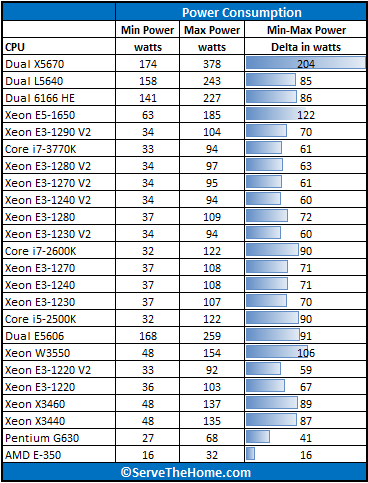
Yikes! Interestingly, total power consumption is lower than the dual Opteron 6166 HE system but is much higher than what we see with Ivy Bridge and Sandy Bridge Intel Xeon processor E3 series CPUs. One thing to remember here is that one needs to use a PCIe video card or onboard GPU with the E5-1650.
Intel Xeon Processor E5-1650 Conclusion
If I were building a 1U or 2U server for colocation, the E3 series makes much more sense. Likewise, in a home storage server on 24×7, I would look at the lower end of the Intel Xeon processor E3-1200 series such as the Intel Xeon processor E3-1240 V2. As a user you save a ton of money on the up-front purchase price and with power over the life of the machine. With that being said, if you are looking for a bit more power, the Intel Xeon processor E5-1650 makes a lot of sense. You do get more performance from the Xeon E5 around the $600 mark and you get more PCIe connectivity and DIMM capacity. On a relative scale, I think that once you hit the level of an Intel Xeon processor E3-1280 V2, you should be looking at the Xeon E5 series unless you have sever power constraints in a data center. One word on availability that I did want to mention: these chips look out of stock everywhere. I contacted Intel about this and found the supply is healthy on the Xeon E5-1650, but they are not stocked by distributors. What that means is that once you order the part, a signal is sent to Intel and the part is released/ sent. Most of the Xeon E3 line is stocked at distributors so there may be a day or two longer lead time on the Intel Xeon E5-1650 parts but seeing back order notices are more of a reflection of distributor/ reseller stock rather than Intel stock.
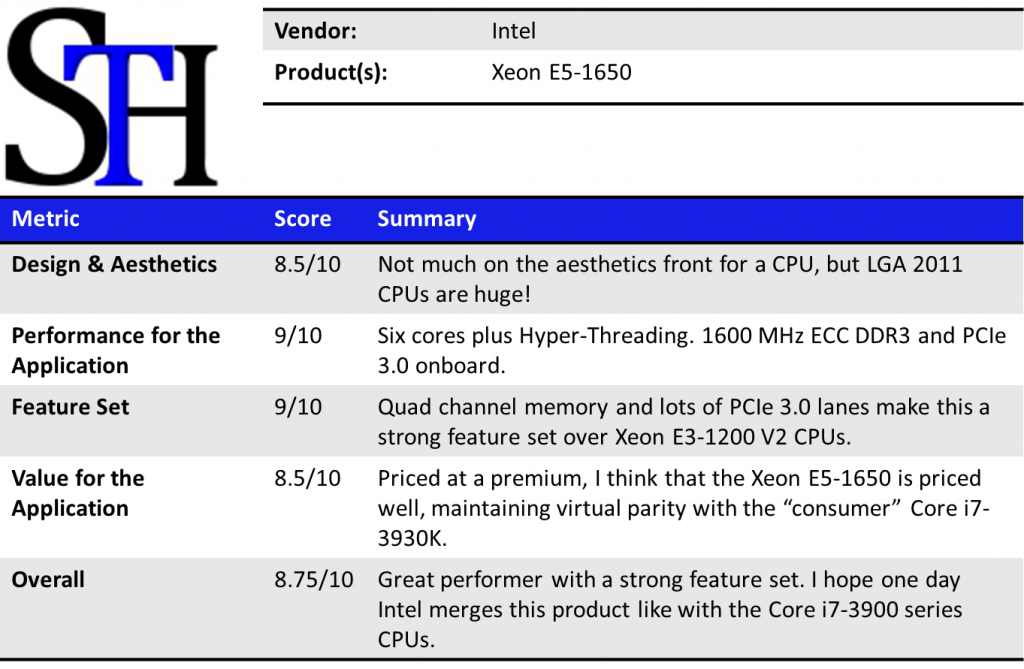


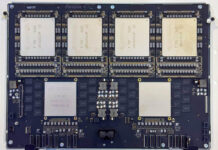

Excellent review, as always Patrick. This CPU is definitely the sweet spot for a business/enterprise class deployment whereas, as you said, the E3-1240V2 is tops for home/lab purposes. Totally concur.
Thanks for the note in the conclusion about the stock/supply issue. I was planning on building a server later this year with this CPU, and I was worried that it was “out of stock” everywhere.
vasudaprime, I think that is a common misconception which is why I contacted Intel about it.
Nice review, as always ;-)
I am shocked by the power draw in idle with that CPU.
Would like to see how it compares to the E5-2620 (SandyBridge-EP) and maybe in a Supermicro X9SRL-F (this combo is my candidate for my next home-server, BTW).
Not really on the power consumption given 8 DIMMs and a high-end X79 motherboard.
Does this Xeon E5-1650 also make up for the lack of Native USB 3.0 and Sata III ports that along with the PCIe 3.0 were either completely missing or were cut back to such an extent that X70 motherboard makers had to turn to Asmedia and Marvell to make up for the USB 3.0 support and the Sata III 6GB/sec prots. For sure it is the only 2011 socket CPU (along with other E5 1600 and 2600 series) cpu that provides which is completely missing in the i7 3820, 3930K, 3960X, and the 3970X.
It has been a life-saver for those that are even aware of the massive limitations of most all X79 motherboards.
Thanks
If you could, assuming you get this message, would you mind emailing me your response. I would like to buy Xeons today and not have to wait for the Ivy Bridge E release in September. Who knows what added support there will be for USB and Sata III. all that is known for sure that after two years the key to unlock at lock motherboard is being provided.